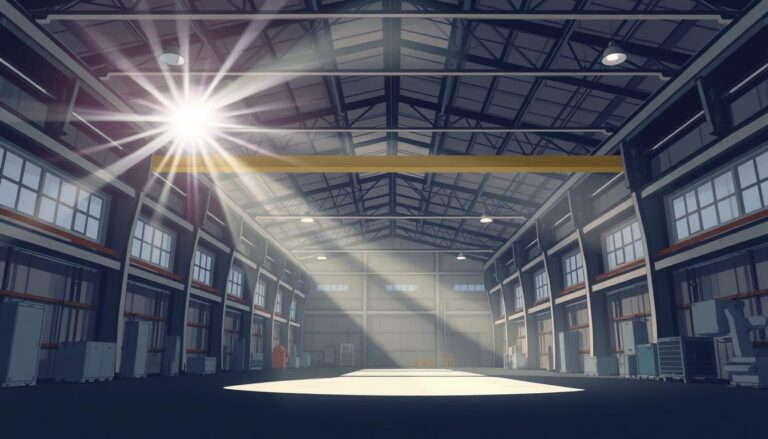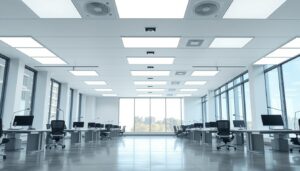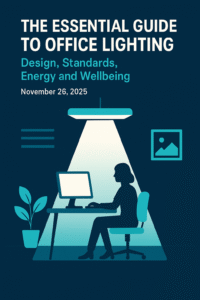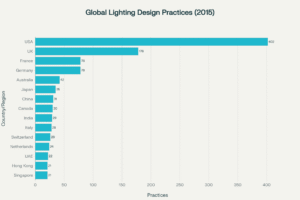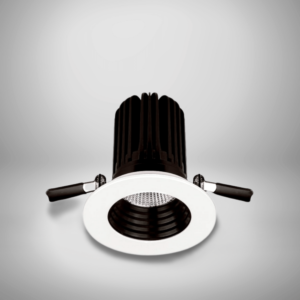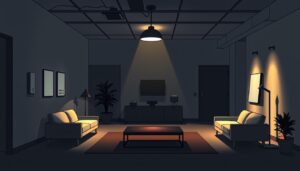Lighting in industrial workspaces goes beyond basic illumination—it’s about creating a safer, more efficient environment that supports productivity and sustainability. In this guide, we’ll explore how to find the ideal lighting setup for industrial facilities, with a look at Lumenloop’s high-performance options designed to meet the unique demands of these settings. As we explore the best lighting for industrial workspaces, we’ll examine how WELL Standards and BREEAM criteria, along with aesthetics and functionality, are shaping the future of lighting in landmark buildings.
Workspace lighting solutions are built on four key pillars: user experience, lighting standards and compliance, design optimisation, and environmental sustainability. This approach is critical in the post-COVID era, where flexible lighting to accommodate varied space uses is essential. By focusing on visual interest, comfort, well-being, and productivity, we can ensure industrial workspaces thrive through strategic lighting use.
Key Takeaways
- Emphasis on site safety and security in properly lighting commercial estates
- Capability to retrofit luminaires with the latest lighting technology for improved working conditions and reduced carbon footprint
- Consideration of WELL Standards and BREEAM criteria in designing lighting solutions for modern workplaces
- Focus on creating visual interest, comfort, well-being, and enhanced productivity through lighting in workspaces
- Prominence of LED technology and smart lighting controls in optimising energy use for workspaces
Understanding Industrial Lighting Requirements and Regulations
Exploring the complex world of industrial lighting can be overwhelming. Yet, grasping the fundamental requirements and regulations is vital for a safe, efficient, and eco-friendly work environment. In the UK, the Health & Safety at Work Act 1974 and the Workplace Regulations Act 1992 form the cornerstone for setting lighting standards across various sectors.
Health & Safety at Work Act Requirements
The Health & Safety at Work Act 1974 demands employers to provide adequate lighting. This ensures employees can carry out their duties safely, without risking their eyesight or health. It highlights the need for suitable light levels, colour rendering, and glare control to foster a comfortable and risk-free workplace.
Workplace Regulations Act Specifications
The Workplace Regulations Act 1992 underlines the necessity for appropriate lighting, preferably natural, and emergency lighting when required. It acknowledges the importance of customising lighting solutions to match the specific tasks and activities in industrial settings.
Industry-Specific Lighting Standards
Industry-specific lighting standards offer detailed guidance on the necessary illumination levels for different industrial tasks. For example, ANSI/IES standards suggest 10-20 foot candles (100-200 lux) for lobbies or dining areas. They recommend 20-50 foot candles (200-500 lux) for areas requiring clear visual clarity and high colour contrast. Lastly, 200-500 foot candles (2,000-5,000 lux) are advised for workstations needing precise visual acuity, such as in electronic assembly.
| Industrial Setting | Recommended Lux Levels |
|---|---|
| Process Control Room | 300 lux |
| Corridor | 50 lux |
| Engineering Drawing Study | 750 lux |
By familiarising oneself with these regulatory demands and industry-specific standards, facilities can implement the most suitable green industrial lighting solutions. This ensures a safe, productive, and energy-efficient workspace.
Types of Industrial Lighting Solutions
High-output industrial lighting fixtures cater to various needs within industrial settings. They range from high bay lighting for vast, open spaces like warehouses to low bay lighting for areas with lower ceilings. This variety allows industrial facilities to tailor their lighting to their unique needs.
Linear lighting fittings ensure uniform illumination across wide areas. Pendant lighting, on the other hand, is perfect for task-specific illumination. These options enable industrial facilities to design customised lighting solutions that meet their specific requirements.
- High bay lighting: Designed for large, open spaces with high ceilings, such as warehouses and manufacturing plants, providing complete light coverage for uniform illumination across the workspace.
- Low bay lighting: Ideal for industrial areas with lower ceiling heights, it offers targeted illumination for specific tasks and work zones.
- Linear lighting: Commonly used to provide uniform, efficient lighting across wide areas, such as in retail spaces, offices, and commercial buildings.
- Pendant lighting: Provides task-specific illumination, often used in workshops, laboratories, and other areas where focused lighting is required.
By using industry leading technologies developed by the likes of Tridonic and Philips, our high-output industrial lighting fittings meet the latest industry standards. These include LG1 and EN 12464, parts 1 and 2. The focus is on simplifying installation and maintenance. High-quality components are used to reduce failures and maintenance needs.
| Lighting Solution | Key Features | Typical Applications |
|---|---|---|
| High Bay Lighting | Designed for large, open spaces with high ceilings; provides complete, uniform illumination | Warehouses, manufacturing plants, distribution centres |
| Low Bay Lighting | Suitable for industrial areas with lower ceiling heights; offers targeted task lighting | Workshops, assembly lines, storage areas |
| Linear Lighting | Delivers uniform, efficient lighting across wide areas; easy to install and maintain | Retail spaces, offices, commercial buildings |
| Pendant Lighting | Provides focused, task-specific illumination; can be adjusted for optimal light placement | Laboratories, workstations, assembly areas |
The company offers a wide range of high-output industrial lighting fixtures. This ensures that industrial facilities can find the right lighting solution for their specific needs. They focus on energy efficiency, durability, and safety.
Best Lighting for Industrial Workspaces: Key Considerations
Choosing the right LED lights for industrial settings involves several key factors. These include light quality, distribution, energy efficiency, and installation needs. Each aspect is vital for a safe, efficient, and sustainable work environment.
Light Quality and Distribution
The quality and spread of light significantly affect the work area. Lumen output, colour rendering index (CRI), and beam angle are critical. They ensure the right light for tasks and comfort. For industrial spaces, a light intensity of about 500 lumens per square metre is often recommended.
Energy Efficiency Factors
Energy efficiency is a major concern in industrial settings, as lighting can consume a lot of energy. LEDs are now, without a doubt, the only lighting choice for their energy-saving benefits, long life, and control over light intensity and colour. For example, simply switching to LED tubes can lead to significant cost reductions, with savings up to £2,529 annually for large offices.
Installation Requirements
Installing industrial lighting must meet safety standards and regulations, like those from the Health and Safety Executive (HSE). Considerations include mounting height, fixture spacing, and maintenance access. The physical space, such as ceiling height and layout, also affects the best lighting setup.
By focusing on these factors, managers and lighting experts can design a lighting system that boosts productivity, safety, and sustainability in industrial areas.
“Good lighting can enhance workplace performance, leading to faster task completion and fewer errors.”
– Cass Business School research
High Bay and Low Bay Lighting Applications
For industrial lighting, high bay and low bay fixtures are the standard choices. High bay lighting, installed on ceilings between 20 to 40 feet, illuminates vast areas like warehouses and manufacturing plants. It provides broad, uniform light. On the other hand, low bay lighting is suited for spaces with ceilings under 20 feet, such as assembly lines and smaller production facilities. It offers focused, task-oriented lighting.
High bay lights are common in warehouses, factories, and large commercial spaces. Low bay fixtures, by contrast, are found in public buildings, restaurants, and storage units. The main difference is their use for different ceiling heights and workspace needs. High bay lights use reflectors or lenses to direct light downwards, while low bay lights have a wider beam angle for even illumination across a broader area.
The advent of energy-efficient LED industrial lights has transformed both high bay and low bay lighting. LED retrofit kits cut energy use and improve light quality, colour rendering, and lifespan over traditional lighting. Their adjustability in brightness, colour temperature, and beam angle makes them ideal for various industrial settings.
High bay and low bay lighting are vital for optimal visibility, productivity, and safety in industrial environments. By choosing the right lighting system, facility managers can create well-lit, energy-efficient, and visually appealing workspaces. These meet the unique needs of their industrial operations.
LED Technology in Industrial Settings
LED lighting has transformed the industrial sector, bringing numerous benefits over traditional lighting. Its energy efficiency is a major advantage, using significantly less electricity than incandescent and fluorescent bulbs. This leads to substantial energy cost savings, providing a notable return on investment for businesses switching to LEDs.
Benefits of LED Industrial Lighting
LED lighting offers more than just energy savings in industrial settings. These lights have a long lifespan, even with continuous use, reducing replacement needs and maintenance costs. This is vital in industrial environments where lights are needed around the clock. LED ceiling and pendant lights also enhance the space’s aesthetic, providing superior brightness and comfort for workers.
Cost-Effectiveness Analysis
Switching to LED lighting in commercial spaces leads to significant energy and maintenance savings, providing a notable return on investment. The UK offers various incentives and rebate programmes to encourage businesses to adopt energy-efficient lighting like LED. Properties with modern, energy-efficient LED lighting are more attractive to buyers and renters, potentially increasing their value and appeal.
Maintenance Considerations
LED technology is designed to withstand industrial environments, leading to fewer replacements and reduced maintenance. This minimises downtime and disruption, allowing businesses to focus on their core activities. Orbito Lighting offers a wide range of industrial LED lighting solutions, catering to diverse needs and providing customised lighting solutions.
By adopting LED technology, industrial facilities can enhance energy efficiency, reduce maintenance costs, and improve safety and productivity. This contributes to a more sustainable future. Orbito Lighting leads the green industrial lighting revolution, providing innovative solutions to help businesses optimise their lighting and achieve sustainability goals.
| Lighting Type | Energy Consumption | Lifespan | Maintenance |
|---|---|---|---|
| Incandescent | High | Short | Frequent |
| Fluorescent | Moderate | Moderate | Periodic |
| LED | Low | Long | Minimal |
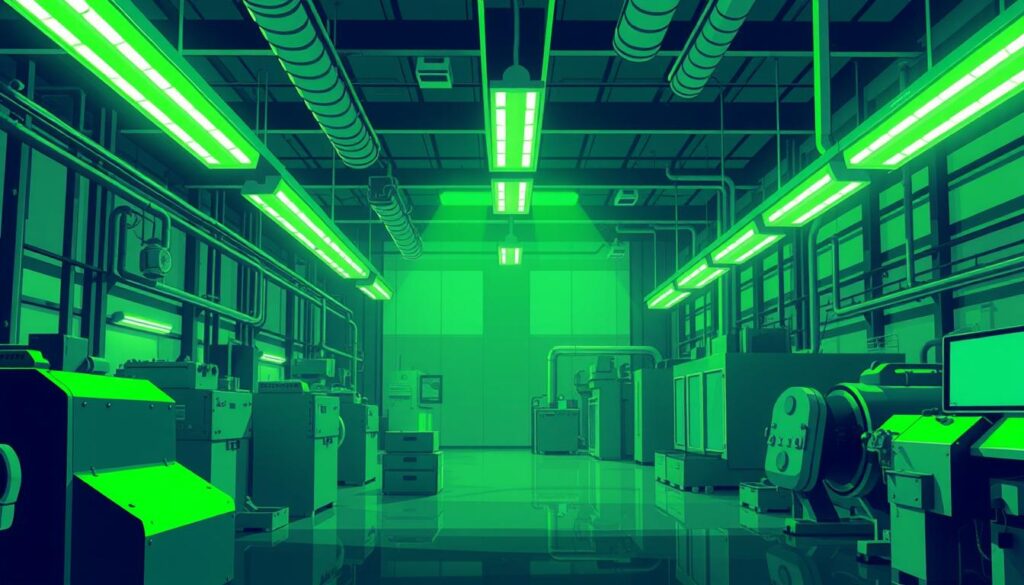
“LED technology has revolutionised industrial lighting, providing superior brightness, energy efficiency, and longevity.”
Lighting Solutions for Manufacturing Facilities
Manufacturing facilities need high-output industrial lighting fixtures for precise tasks and machinery operation. The right lighting ensures both people and equipment are well-lit for safety reasons.
Task lighting for inspection stations and assembly lines is vital. It reduces eye strain and fatigue. This allows employees to work more efficiently and accurately, improving productivity.
OSHA guidelines suggest general manufacturing areas should have at least 30 foot-candles (fc) of light. Detailed inspection tasks may need up to 100 foot-candles (fc) for proper lighting. Cooler colour temperatures (5000K-6500K) are best as they keep workers alert and productive.
Powerful led lights for industrial use are energy-efficient and last longer than traditional lighting. Switching to LED, using lighting controls, and natural light can make lighting systems more sustainable and cost-effective in manufacturing.
- Modular lighting systems and mobile light fixtures are recommended to adapt to layout changes and equipment introductions.
- Choosing durable lighting fixtures and components is key in industrial settings. They must withstand harsh environments and need little maintenance.
- Proper glare control and consistent illumination are vital for visual comfort and a productive work environment.
| Lighting Metric | Recommended Levels |
|---|---|
| General Manufacturing Areas | Minimum 30 foot-candles (fc) |
| Detailed Inspection Tasks | Up to 100 foot-candles (fc) |
| Colour Temperature | 5000K-6500K (Cooler Tones) |
“Proper lighting has been proven to improve employee productivity by reducing eye strain and fatigue, hereby boosting efficiency and motivation.”
Warehouse and Distribution Centre Lighting Design
Warehouses and distribution centres are vital for modern supply chains, needing specific lighting to ensure speed, accuracy, and safety. The strategic use of powerful led lights for industrial use is very useful in these large facilities. It ensures the best illumination, reduces shadows, prevents glare and can help to define a safe perimeter to the building.
Aisle and Racking Illumination
Good lighting in aisles and racking is essential for efficient inventory management and accident prevention. LED lights, with their energy efficiency, long lifespan, and high-quality light, are the top choice for warehouses. By placing LED fixtures wisely, operators can boost visibility, productivity, and cut down on maintenance costs.
Loading Bay Requirements
Lighting in loading bays is critical for safe and efficient goods movement. Well-lit docks support smooth operations and a safer workplace. LED technology in loading bay lighting cuts energy use and maintenance, boosting facility sustainability.
Emergency Lighting Solutions
Warehouses and distribution centres need strong emergency lighting to keep employees and visitors safe during power outages or emergencies. LED emergency lights, with their long life and reliable performance, are perfect for these critical roles. They provide the necessary light to guide people to safety.
By focusing on LED lighting in warehouses and distribution centres, managers can create an environment that’s energy-efficient, cost-effective, and safe. This environment also promotes productivity and employee well-being.
| Lighting Technology | Energy Efficiency | Lifespan | Maintenance Needs |
|---|---|---|---|
| Fluorescent | High | Moderate | Moderate |
| LED | Excellent | Exceptional | Low |
| HID | High | Moderate | High |
As the industry evolves, the use of powerful LED lights in warehouses and distribution centres will be key. They drive efficiency, sustainability, and safety across the supply chain.
Environmental Impact and Sustainability Measures
Businesses are increasingly focusing on environmental responsibility, making green industrial lighting solutions essential. Sustainable lighting options not only save costs but also play a key role in reducing industrial facilities’ environmental impact.
Energy-efficient lighting, like LED technology, offers significant benefits. LEDs can cut energy use by up to 75% compared to traditional bulbs. Their lifespan of 25,000 to 50,000 hours also reduces maintenance costs. This leads to a lower carbon footprint and supports the circular economy, encouraging maximum resource reuse.
- LED lights have a lifespan 25 times longer than traditional incandescent bulbs, reducing waste and maintenance.
- Occupancy sensors and timers can automatically adjust lighting based on activity, minimising energy wastage.
- Luminaire refurbishment and lighting-as-a-service (LaaS) models contribute to a more sustainable lighting infrastructure.
Other sustainable measures, such as using renewable materials and biophilic design, can further improve industrial workspaces’ environmental impact. Biophilic design aims to reduce the need for artificial lighting and heating, lowering energy consumption.
| Lighting Solution | Energy Efficiency | Lifespan | Maintenance Cost |
|---|---|---|---|
| LED | High | 50,000+ hours | Low |
| Incandescent | Low | 1,000 – 2,000 hours | High |
| HID | Moderate | 10,000 – 20,000 hours | Moderate |
By embracing these sustainable lighting solutions and environmental measures, industrial facilities can greatly reduce their carbon footprint. They can also achieve cost savings and contribute to a more sustainable future.
Control Systems and Smart Lighting Integration
Improving the efficiency and functionality of industrial lighting is essential. Advanced control systems play a key role in this. They work seamlessly with energy-efficient LED industrial lights. This optimises energy use and creates lighting environments that adapt to occupancy and natural light.
Motion Sensors and Automation
Presence detection systems control lighting aisle by aisle, leading to significant energy savings. They switch off lights in unoccupied areas and turn them on when someone enters. Integral lighting controls in luminaires also save energy by detecting daylight and occupancy. This reduces installation time and costs.
Daylight Harvesting Systems
- Daylight dimming in industrial settings can cut energy consumption by using rooflights to bring in daylight.
- Daylight harvesting technology can save 25-40% in lighting energy by adjusting light levels based on daylight.
- Implementing absence detection features can reduce energy usage by 20-30% by adjusting lighting levels based on occupancy.
Using advanced control systems and smart lighting integration offers many benefits. These include increased energy efficiency, cost savings, and enhanced productivity. By tailoring lighting to specific zones and activities, facilities can optimise energy use. This creates a more comfortable and productive work environment.
“Implementing wireless intelligent lighting control systems can enhance building flexibility, reduce installation costs, and integrate seamlessly into wider building management systems.”
The strategic use of control systems and smart lighting integration is vital for industrial facilities. It enhances energy efficiency, sustainability, and operational effectiveness.
Safety and Risk Management in Industrial Lighting
Ensuring a safe and managed industrial environment is critical, with lighting playing a key role. High-output fixtures with high IP ratings are vital for harsh settings. They protect against dust, moisture, and other dangers that threaten worker safety.
Glare control is essential, as too much light or uneven illumination can hinder visibility. This increases accident risks. Solutions that offer even light and reduce reflections help workers see clearly. They can then spot hazards more easily.
Following safety standards like DIN EN 1838 and DIN EN 13032-3 for emergency lighting is also critical. By using these strong systems, facilities can keep their workforce safe. This is true even when the main lighting fails.
FAQ
What are the key factors to consider when selecting industrial lighting?
When choosing industrial lighting, consider the task’s purpose and requirements. Also, think about mounting height and spacing, lumen output, and efficacy. Light quality, colour rendering index (CRI), energy efficiency, and safety compliance are also important.
What are the benefits of LED lighting for industrial applications?
LED lighting brings many advantages to industrial settings. It’s energy-efficient, has a long lifespan, and requires less maintenance.
How can industrial lighting contribute to safety and risk management?
Proper lighting is key to managing risks in industrial environments. It controls glare, ensures visibility in hazardous areas, and meets safety standards. High IP ratings for dust and moisture resistance are vital in challenging settings.
What are the differences between high bay and low bay lighting in industrial settings?
High bay lighting is used on high ceilings, illuminating large areas like warehouses. Low bay lighting fits areas with lower ceilings, such as manufacturing plants. It provides focused illumination for specific tasks.
How can smart lighting control systems enhance industrial lighting efficiency?
Smart lighting control systems boost industrial lighting efficiency. They use motion sensors, automation, and daylight harvesting. These systems optimise energy use and adapt lighting to the environment.
What are the key requirements for lighting in warehouses and distribution centres?
Warehouses and distribution centres need specific lighting designs. They must balance speed, accuracy, and safety. Solutions for aisle and racking illumination, loading bay lighting, and emergency lighting are critical in these large facilities.
How can industrial lighting contribute to sustainability and environmental impact reduction?
Sustainable lighting solutions are essential for reducing environmental impact. They include energy-efficient fixtures, long-life components, and controls that cut energy use in low-activity areas. These measures save costs and help the environment in industrial settings.
